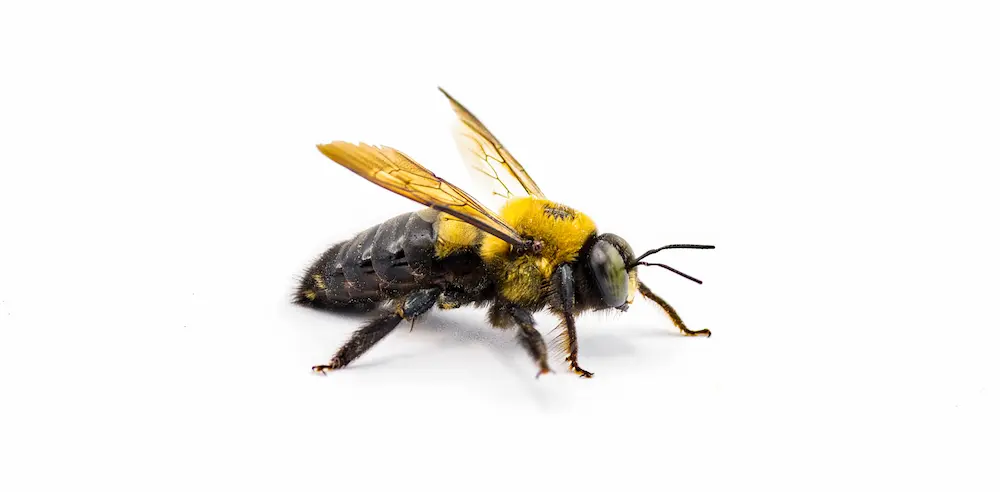Diy Methods For Getting Rid of Carpenter Bee
Don't wait - every day increases health risks and property damage. These aggressive rodents multiply rapidly and spread dangerous diseases.
Professional elimination is the ONLY safe and effective solution. DIY methods fail 90% of the time and can make the problem worse.
24 Hours
Average response time
100%
Satisfaction guarantee

Carpenter Bee
.svg)
Most common DIY methods of getting rid of Carpenter Bee
Learn effective tips to keep carpenter bees away from your home and protect your wood structures naturally.
Call for Emergency ServicePrevention Method
🛠️ Tools:
- Citrus essential oil
- Spray bottle
- Water
- Caulk
- Wood filler
- Paint or varnish
- Paintbrush or roller (for applying paint/varnish)
- Rags or paper towels (for cleanup)
How to do it:
Use a DIY prevention method by applying citrus oil spray to wood surfaces.
Result:
- Mix water with citrus essential oil in a spray bottle.
- Spray the mixture on exposed wood, especially in areas where carpenter bees are active.
- Repeat application every few days during bee season.
- Seal cracks and holes in wood with caulk or wood filler.
- Paint or varnish wood surfaces to deter bees.
Problem:
This method may fail if the citrus scent fades quickly, if bees are already nesting inside the wood, or if all entry points are not properly sealed.
Natural and Non-toxic Method
🛠️ Tools:
- Citrus oil (orange or lemon)
- Water
- Spray bottle
- Measuring cup or spoon (for equal parts mixing)
- Clean cloth or paper towel (optional, for wiping surfaces)
How to do it: Mix equal parts citrus oil (like orange or lemon) with water in a spray bottle. Spray the mixture on wood surfaces where carpenter bees are active. Repeat every few days, especially after rain.
Result: The citrus scent repels carpenter bees, discouraging them from boring into wood and causing damage.
Problem: This method may fail if the scent fades quickly, if rain washes it away, or if bees are already nesting inside the wood.
Chemical Method
🛠️ Tools:
- Vacuum cleaner or insect net
- Wood putty or caulk
- Putty knife or caulking gun
- Fine mesh screens
- Scissors or utility knife (for cutting mesh)
- Staple gun or nails (to secure mesh)
- Exterior paint or wood varnish
- Paintbrush or roller
- Ladder (if needed for high areas)
- Flashlight (for inspecting holes and entry points)
How to do it:
Physically remove carpenter bees and block their access points.
Result:
- Locate and remove visible carpenter bees using a vacuum or net.
- Seal existing holes with wood putty or caulk.
- Install fine mesh screens over vents and openings.
- Paint or varnish exposed wood surfaces to deter nesting.
- Regularly inspect and re-seal any new holes.
Problem:
This method may fail if bees find or create new entry points, or if all existing nests are not detected and sealed.
Physical Removal & Exclusion
🛠️ Tools:
- Beneficial nematodes (appropriate species for carpenter bees)
- Parasitic wasps (appropriate species for carpenter bees)
- Gloves (for handling and releasing agents)
- Watering can or sprayer (for applying nematodes if needed)
- Instructions/manual for application (usually provided with purchase)
- Access to carpenter bee nesting sites (e.g., ladder if nests are elevated)
How to do it:
Use nematodes or parasitic wasps as biological control agents to target carpenter bee larvae.
Result:
- Purchase beneficial nematodes or parasitic wasps online or at garden centers.
- Release them near carpenter bee nesting sites outside your home.
- These natural predators attack and reduce carpenter bee larvae populations, discouraging further nesting.
Problem:
This method may fail if the predators do not establish well, if the infestation is already severe, or if bees have already entered your home. Environmental factors may also limit effectiveness.
Biological Control (Eco-Friendly)
🛠️ Tools:
- Insecticidal dust or spray (e.g., carbaryl or permethrin)
- Applicator for dust or spray (duster or spray bottle)
- Protective gloves
- Safety goggles or glasses
- Dust mask or respirator
- Wood putty
- Putty knife or applicator
- Ladder (if treating elevated areas)
- Flashlight (to inspect holes)
- Cleaning cloths or rags
How to do it:
Use a chemical DIY method by applying insecticidal dust or spray (such as carbaryl or permethrin) directly into carpenter bee holes. Seal holes with wood putty after treatment. Repeat every spring and fall.
Result:
- Kills existing bees inside tunnels
- Prevents new bees from entering
- Reduces future infestations
- Protects wood goods from further damage
Problem:
This method may fail if all tunnels are not treated, if bees have already left, or if chemicals are not reapplied regularly.
Stop Wasting Time and Money
The average homeowner spends $200+ on failed DIY attempts before calling professionals. Meanwhile, the infestation grows worse.
Best DIY Method To Get Rid Of Carpenter Bee
Carpenter bees are large, black-and-yellow bees that drill round holes into wood to create nests. They don’t eat wood, but their tunneling can damage wooden structures, furniture, and even cause long-term issues if left unchecked. The best DIY method to prevent carpenter bees from getting inside your house and damaging your goods is to make your home and its wooden surfaces unattractive and inaccessible to them.
Seal and Protect All Exposed Wood
Carpenter bees prefer untreated, unpainted, or weathered wood. To keep them away:
- Paint or varnish all exposed wood surfaces—including doors, window frames, eaves, decks, and outdoor furniture. Bees are much less likely to drill into painted or sealed wood.
- Fill existing holes with wood putty or caulk, then sand and paint over them. Carpenter bees often return to old holes, so sealing these up is crucial.
- Install metal or vinyl coverings on vulnerable areas like fascia boards and trim. These materials are impossible for bees to drill into.
Use Physical Barriers and Repellents
- Hang bee deterrent bags (like brown paper bags or fake wasp nests) near problem areas. Carpenter bees avoid places where they think predators or other colonies are present.
- Apply citrus oil spray to wood surfaces. Boil citrus peels in water, strain, and spray the liquid on wood. Carpenter bees dislike the smell and will avoid treated areas.
Regular Inspection and Maintenance
- Inspect your home every spring for new holes or bee activity. Early detection makes control much easier.
- Repair and repaint wood annually to maintain a strong barrier against carpenter bees.
Read more detailed instructions for each method
Natural/Organic Methods
Discover safe, natural stinging insect control solutions for your home and garden.
Read MoreHeading 1
Heading 2
Heading 3
Heading 4
Heading 5
Heading 6
Lorem ipsum dolor sit amet, consectetur adipiscing elit, sed do eiusmod tempor incididunt ut labore et dolore magna aliqua. Ut enim ad minim veniam, quis nostrud exercitation ullamco laboris nisi ut aliquip ex ea commodo consequat. Duis aute irure dolor in reprehenderit in voluptate velit esse cillum dolore eu fugiat nulla pariatur.
Block quote
Ordered list
- Item 1
- Item 2
- Item 3
Unordered list
- Item A
- Item B
- Item C
Bold text
Emphasis
Superscript
Subscript
Mechanical/Physical Methods
Discover safe, effective mechanical methods for stinging insect control. Protect your home today!
Read MoreHeading 1
Heading 2
Heading 3
Heading 4
Heading 5
Heading 6
Lorem ipsum dolor sit amet, consectetur adipiscing elit, sed do eiusmod tempor incididunt ut labore et dolore magna aliqua. Ut enim ad minim veniam, quis nostrud exercitation ullamco laboris nisi ut aliquip ex ea commodo consequat. Duis aute irure dolor in reprehenderit in voluptate velit esse cillum dolore eu fugiat nulla pariatur.
Block quote
Ordered list
- Item 1
- Item 2
- Item 3
Unordered list
- Item A
- Item B
- Item C
Bold text
Emphasis
Superscript
Subscript
Chemical Methods
Effective chemical solutions for stinging insect control. Safe, fast, and reliable results.
Read MoreHeading 1
Heading 2
Heading 3
Heading 4
Heading 5
Heading 6
Lorem ipsum dolor sit amet, consectetur adipiscing elit, sed do eiusmod tempor incididunt ut labore et dolore magna aliqua. Ut enim ad minim veniam, quis nostrud exercitation ullamco laboris nisi ut aliquip ex ea commodo consequat. Duis aute irure dolor in reprehenderit in voluptate velit esse cillum dolore eu fugiat nulla pariatur.
Block quote
Ordered list
- Item 1
- Item 2
- Item 3
Unordered list
- Item A
- Item B
- Item C
Bold text
Emphasis
Superscript
Subscript
Preventive Measures
Effective stinging insect control tips and prevention for a safer, pest-free environment.
Read MoreHeading 1
Heading 2
Heading 3
Heading 4
Heading 5
Heading 6
Lorem ipsum dolor sit amet, consectetur adipiscing elit, sed do eiusmod tempor incididunt ut labore et dolore magna aliqua. Ut enim ad minim veniam, quis nostrud exercitation ullamco laboris nisi ut aliquip ex ea commodo consequat. Duis aute irure dolor in reprehenderit in voluptate velit esse cillum dolore eu fugiat nulla pariatur.
Block quote
Ordered list
- Item 1
- Item 2
- Item 3
Unordered list
- Item A
- Item B
- Item C
Bold text
Emphasis
Superscript
Subscript
.svg)
Serious Health Risks to Your Family
Pests can seriously harm you and your loved ones. Don't gamble with your family's health.
Within 24 hours
Allergic Reactions
Anaphylaxis, airway obstruction
Onset: Within minutes to a few hours
Within 24 hours
Stings and localized swelling
Allergic reaction, anaphylaxis
Onset: Within minutes to a few hours
Within 24 hours
Respiratory issues from inhaling wood dust created by carpenter bee activity.
Chronic bronchitis, impaired lung function
Chronic bronchitis, impaired lung function
Within 24 hours
Mold growth due to moisture accumulation in damaged wood.
Respiratory infections, allergic reactions
Onset: Within 24-48 hours
Within 24 hours
Secondary bacterial infections from open wounds caused by carpenter bee activity.
Tissue necrosis, sepsis
Onset: Within 24-72 hours
Within 24 hours
Structural weakening leading to potential injury from collapsing wood.
Bone fractures, traumatic brain injury
Onset: Within weeks to months
Protect Your Family Today
Professional pest control eliminates health risks immediately. Our safe, effective treatments protect your loved ones from dangerous diseases.
.svg)
Professional Solution That Actually Works
Our certified technicians eliminate pest infestations completely and permanently.
Here's what you get:
🔍
Immediate Assessment
Trained experts identify entry points and nesting areas
🛡️
Safe Treatment
Pet and family-friendly methods used
🎯
Complete Elimination
Targets entire colony, not just visible insects or rodents
📋
Prevention Plan
Long-term exclusion strategies
🧽
Health Protection
Proper cleanup and sanitization
✅
Guarantee
Service warranty and follow-up visits
Our 3-Step Elimination Process
🔍
1. Immediate Inspection
Complete property assessment within 24 hours
🎯
2. Targeted Elimination
Safe, effective treatment of entire colony
🛡️
3. Prevention Plan
Long-term exclusion and monitoring
Ready to Solve This Problem Forever?
Join thousands of satisfied customers who chose professional pest control.
100% satisfaction guarantee.
Licensed & Insured • Same-Day Service • 100% Guarantee*



